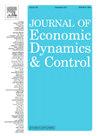Monetary policy and credit flows: A tale of two effective lower bounds
IF 2.3
3区 经济学
Q2 ECONOMICS
引用次数: 0
Abstract
This paper evaluates the quantitative effects of monetary policy on credit flows. Using Compustat data and a factor-augmented vector autoregression where monetary policy shocks are identified via an external instrument, we show that monetary policy promotes long-term credit creation while delaying or preventing long-term credit destruction. In parallel, it reduces short-term credit creation and destruction, effectively reallocating credit toward longer maturities. Focusing on two effective lower bound periods, we show that monetary policy prompted a reshuffling of credit toward financially constrained firms, notably small, young, and high-default-probability firms. Our findings underscore the effectiveness of monetary policy in steering credit toward financially constrained firms and stimulating future economic activity near the effective lower bound.
货币政策与信贷流动:两个有效下限的故事
本文评估了货币政策对信贷流动的定量影响。使用Compustat数据和因子增强向量自回归(通过外部工具识别货币政策冲击),我们表明货币政策促进长期信贷创造,同时延迟或防止长期信贷破坏。与此同时,它减少了短期信贷的创造和破坏,有效地将信贷重新分配给期限较长的市场。聚焦于两个有效的下限时期,我们表明货币政策促使信贷重新洗牌,流向财务受限的公司,特别是小型、年轻和高违约概率的公司。我们的研究结果强调了货币政策在引导信贷流向财务受限企业和刺激接近有效下限的未来经济活动方面的有效性。
本文章由计算机程序翻译,如有差异,请以英文原文为准。
求助全文
约1分钟内获得全文
求助全文
来源期刊

Journal of Economic Dynamics & Control
ECONOMICS-
CiteScore
3.10
自引率
10.50%
发文量
199
期刊介绍:
The journal provides an outlet for publication of research concerning all theoretical and empirical aspects of economic dynamics and control as well as the development and use of computational methods in economics and finance. Contributions regarding computational methods may include, but are not restricted to, artificial intelligence, databases, decision support systems, genetic algorithms, modelling languages, neural networks, numerical algorithms for optimization, control and equilibria, parallel computing and qualitative reasoning.
 求助内容:
求助内容: 应助结果提醒方式:
应助结果提醒方式:


